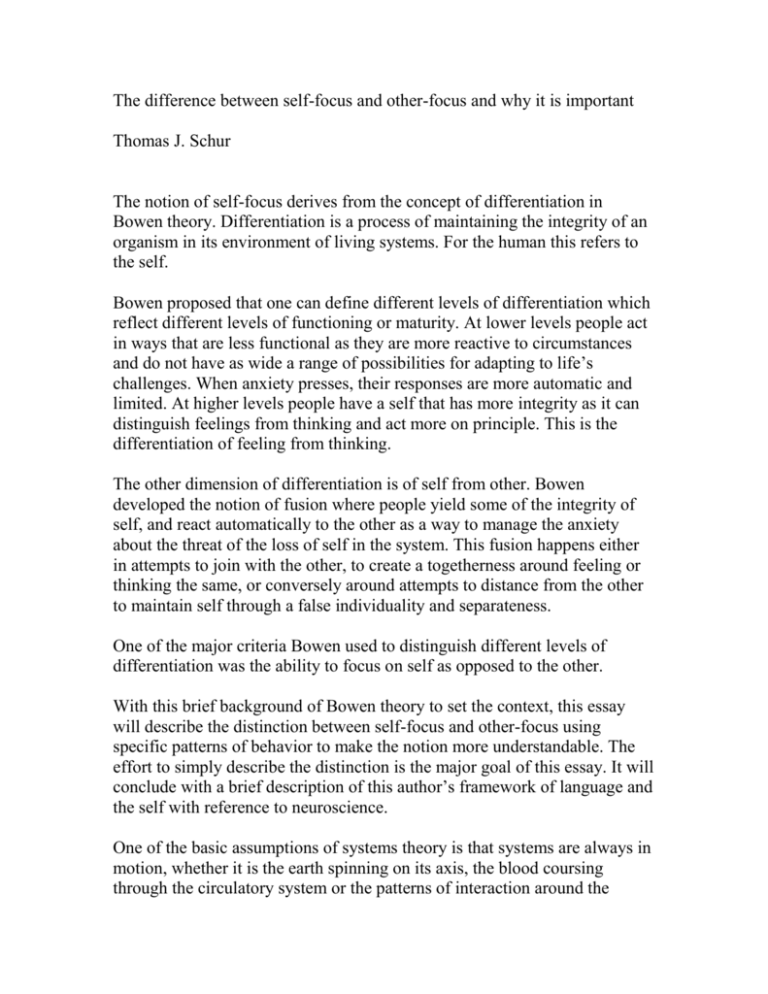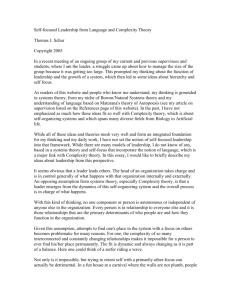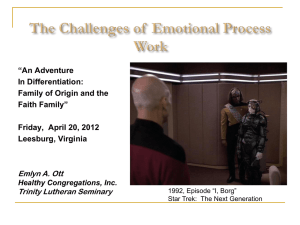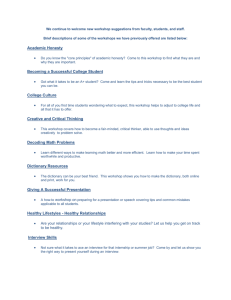The difference between self-focus and other
advertisement

The difference between self-focus and other-focus and why it is important Thomas J. Schur The notion of self-focus derives from the concept of differentiation in Bowen theory. Differentiation is a process of maintaining the integrity of an organism in its environment of living systems. For the human this refers to the self. Bowen proposed that one can define different levels of differentiation which reflect different levels of functioning or maturity. At lower levels people act in ways that are less functional as they are more reactive to circumstances and do not have as wide a range of possibilities for adapting to life’s challenges. When anxiety presses, their responses are more automatic and limited. At higher levels people have a self that has more integrity as it can distinguish feelings from thinking and act more on principle. This is the differentiation of feeling from thinking. The other dimension of differentiation is of self from other. Bowen developed the notion of fusion where people yield some of the integrity of self, and react automatically to the other as a way to manage the anxiety about the threat of the loss of self in the system. This fusion happens either in attempts to join with the other, to create a togetherness around feeling or thinking the same, or conversely around attempts to distance from the other to maintain self through a false individuality and separateness. One of the major criteria Bowen used to distinguish different levels of differentiation was the ability to focus on self as opposed to the other. With this brief background of Bowen theory to set the context, this essay will describe the distinction between self-focus and other-focus using specific patterns of behavior to make the notion more understandable. The effort to simply describe the distinction is the major goal of this essay. It will conclude with a brief description of this author’s framework of language and the self with reference to neuroscience. One of the basic assumptions of systems theory is that systems are always in motion, whether it is the earth spinning on its axis, the blood coursing through the circulatory system or the patterns of interaction around the family dinner table. To talk about a stable entity like a chair standing on the floor without moving, or a person at rest while his or her heart beats regularly, or a child sitting at the table eating dinner, is to talk about a system that achieves stability by being in balance. None of these are static events. Differentiation relates to how the self achieves that balance in social systems. Sometimes the balance is more precarious when there is a wide range of reactivity as people overreact to the anxiety in the system. They have a bad temper and get very angry over little affronts, or they get very withdrawn misperceiving rejection, or they drink too much or they try to help too much or they worry too much or they lash out at their children or they over-protect their children. At higher levels of differentiation, people are able to maintain more steadiness over the long-term, as the balance of the self in the system does not fluctuate across as wide a range. For Bowen the work to change self to operate at higher levels of differentiation involves constant efforts to focus more on self than other. When confronted with anxiety, the predictable pattern is to focus on the other, whether it be one’s child, one’s parent, one’s spouse, boss, neighbor and so forth, in the effort to calm down oneself. These are attempts to regulate self in managing the anxiety by focusing on the external, outside of self. Because this tendency is so basic and common, it may be helpful to describe specific examples of it so people can recognize how they do it. [brief paragraph here about P/L Situation: A son with his father Subject of anxiety: Son not sure about taking a new job Pattern of Other-focus: Son continually seeks father's approval Denial system: Limitation Shift to Self-focus: Son makes own judgment about job, talks with father and then acts on own overall assessment Situation: Wife with husband Subject of anxiety: Wife angry with husband for not agreeing with her Pattern of Other-focus: Wife constantly blames husband as incompetent Denial system: Potential Shift to Self-focus: Wife reflects on nature of the conflict, the validity of her position and her part in keeping the conflict going and then engages husband in conflict as peer Situation: A woman trying to lose weight Subject of anxiety: Dieting Pattern of Other-focus: Ideal self-image Denial system: Limitation Shift to Self-focus: Woman reflects on patterns of weight gains and losses and on need to lose weight for self, not for others (husband, society) to get to own sense of appropriate weight Situation: Teacher in a classroom Subject of anxiety: Concern with students liking him Pattern of Other-focus: Continual monitoring of student's reactions and modifying presentations and exams to please. Denial system: Limitation Shift to Self-focus: Teacher considers what is essential material of the curriculum and his particular contribution and explores how best to engage students from that position. Situation: Teenage daughter with parents Subject of anxiety: Need to be independent and not have curfews Pattern of Other-focus: Continual conflict with parents as rebel Denial system: Potential Shift to Self-focus: Teenager controls rebel reflex and considers what she needs from her parents and what she doesn't, and talks with them about those needs. Situation: Worker with his foreman Subject of anxiety: Worker is afraid boss does not think he can do the job and may fire him Pattern of Other-focus: Worker continually asks for feedback on his job performance Denial system: Limitation Shift to Self-focus: Makes own assessment about own ability to the job; if conclusion is not good enough, asks for help; if conclusion is competence, just does the job. Situation: Political candidate Subject of anxiety: Concern about low poll numbers and risk of losing election Pattern of Other-focus: Portraying other candidate as incompetent Denial system: Potential Shift to Self-focus: Consider own vision as political leader and work from there to assess the strengths and weaknesses of own positions, and use that to engage the electorate. Situation: Prisoner in jail Subject of anxiety: Unfairness of incarceration Pattern of Other-focus: Blaming authorities with being out to get him Denial system: Potential Shift to Self-focus: Reflecting on what he did do, accepting responsibility for that, and then evaluating the responses of others as fair or unfair. Situation: Mother of sick child Subject of anxiety: Concern that she could have done better to prevent this illness Pattern of Other-focus: Continually asking child how she is feeling, for reassurance Denial system: Limitation Shift to Self-focus: Reflect with self and others on what she did that did create problems for child, feel bad, and take care of child keeping anxiety to herself Situation: Young investor in stock market Subject of anxiety: Need to make a lot of money so will not have to work Pattern of Other-focus: Obsessive focus on the fluctuations of the markets Denial system: Potential Shift to Self-focus: Reflection on own life goals and then on strategies to achieve them In each of these situations the “Pattern of other-focus” identifies an automatic response, a reflex. The “Shift to self-focus” delineates the effort to control that reactivity and take action based on more differentiation between feelings and thinking and between self and other. All of the above, the conceptual introduction and the examples reflect Bowen theory. This essay will conclude with a few remarks that contextualize this material into my framework of language an existential anxiety. The very notion of a self is a construct in language. Presumably animals do not reflect on a self as they go about their daily struggle to survive. My contention is that the awareness that language allows of one’s own existence with a past and a future leads to the major anxiety of one’s mortality. If one can reflect on one’s existence it is not much of a leap to recognize one’s own eventual demise. Like the animals, we have the powerful fight/flight instinct of survival. Unlike them, we have that anxiety with no immanent threat. It is language that allows us these thoughts. A human’s hypervigilant focus on the external world is a more primitive level of functioning in response to the inevitable human dilemma of existential anxiety created by self-awareness. It is an attempt to regulate self by trying to gain self control through management of the external environment The shift to a focus on self is difficult because it increases the existential anxiety as one recognizes one’s vulnerability as a distinct organism in a larger world of living systems. On the other hand, it can also be productive as one can better assess one’s place and participation in the dynamic of various systems, and use the brain to think through the best responses for survival and optimal functioning. This is why the shift from other-focus to self-focus is so challenging but also why it can be so powerful. My way is to use language, where thinking and talking is grounded in a primary orientation to self, that leads to action and experimentation with others in a continually recursive loop. Sometimes people get confused and think that a focus on self moves in the direction of exclusion of the outside world. It is just the opposite. With the shift to a primary orientation to the self, one is able engage others in the external world more fully, as one can trust oneself to handle what the external world presents. With a primary other-focus orientation, one engages others cautiously and selectively in a continual attempt to anticipate their responses, never able to interact in the present. This is not to say that one always has to be actively engaged in the external world. Sometimes one’s assessment leads to a decision to withdraw and not engage, based on sound judgment of self in a dangerous or unproductive situation. (So, from a selffocused position one can make better decisions to engage others or not.)









